A Comprehensive Assessment of Climate Change and Coastal Inundation through Satellite-Derived Datasets: A Case Study of Sabang Island, Indonesia
Abstract
:1. Introduction
2. Case Study Area: Sabang Island
3. Methodology
3.1. Data Sources
3.2. Assessment of Land Use/Land Cover Change
3.2.1. Enhanced Vegetation Index (EVI)
3.2.2. Normalised Difference Built-Up Index (NDBI)
3.3. Trend Analysis
3.3.1. Mann-Kendall Test
3.3.2. Sen’s Slope Estimator
3.4. Modelling of Coastal Inundation
3.5. Vulnerability of Built-Up Areas
4. Results
4.1. Climate Change in Sabang Island
4.2. Sea Level Rise
4.3. Changes in Land Use/Land Cover
4.4. Coastal Inundation and Built-Up Areas
5. Discussion
6. Conclusions
Author Contributions
Funding
Data Availability Statement
Conflicts of Interest
References
- Rebecca Lindsey, L.D. Climate Change: Global Temperature. Available online: https://www.climate.gov/news-features/understanding-climate/climate-change-global-temperature#:~:text=Earth’s%20temperature%20has%20risen%20by,land%20areas%20were%20record%20warm (accessed on 29 April 2022).
- CO2:earth. 2022 CO2.Earth. Available online: https://www.co2.earth/global-warming-update (accessed on 29 April 2022).
- IUCN Occean Warming. 2022 International Union for Conservation of Nature. Available online: https://www.iucn.org/resources/issues-briefs/ocean-warming#:~:text=Data%20from%20the%20US%20National,over%20the%20past%20100%20years (accessed on 29 April 2022).
- Lindsey, R. Climate Change: Global Sea Level. Available online: https://www.climate.gov/news-features/understanding-climate/climate-change-global-sea-level#:~:text=In%202020%2C%20global%20sea%20level,per%20year%20from%202006%E2%80%932015 (accessed on 29 April 2022).
- Blunden, J.; Boyer, T. State of the Climate in 2020. Bull. Am. Meteorol. Soc. 2021, 102, S1–S475. [Google Scholar] [CrossRef]
- Wong, P.P.; Boon-Thong, L.; Leung, M.W.H. Hot Spots of Population Growth and Urbanisation in the Asia-Pacific Coastal Region. In Global Change and Integrated Coastal Management: The Asia-Pacific Region; Harvey, N., Ed.; Springer: Dordrecht, The Netherlands, 2006; pp. 163–195. [Google Scholar] [CrossRef]
- Bank, W. Advancing Disaster Risk Financing and Insurance in ASEAN Member States: Framework and Options for Implementation; World Bank: Washington, DC, USA, 2012; Available online: http://hdl.handle.net/10986/12627 (accessed on 29 April 2022).
- Dewi, R.G. Indonesia Second National Communication under the United Nations Framework Convention on Climate Change (UNFCCC); Ministry of Environment, Republic of Indonesia: Jakarta, Indonesia, 2010. Available online: http://unfccc.int/files/national_reports/non-annex_i_natcom/submitted_natcom/application/pdf/indonesia_snc.pdf (accessed on 29 April 2022).
- Kurniawan, R.; Harsa, H.; Nurrahmat, M.H.; Sasmito, A.; Florida, N.; Makmur, E.E.S.; Swarinoto, Y.S.; Habibie, M.N.; Hutapea, T.F.; Sudewi, R.S.; et al. The Impact of Tropical Cyclone Seroja to The Rainfall and Sea Wave Height in East Nusa Tenggara. IOP Conf. Ser. Earth Environ. Sci. 2021, 925, 012049. [Google Scholar] [CrossRef]
- World Bank Population Growth (Annual%)-Indonesia. 2022 Wolrd Bank. Available online: https://data.worldbank.org/indicator/SP.POP.GROW?locations=ID (accessed on 10 April 2022).
- Neumann, B.; Vafeidis, A.T.; Zimmermann, J.; Nicholls, R.J. Future coastal population growth and exposure to sea-level rise and coastal flooding-a global assessment. PLoS ONE 2015, 10, e0118571. [Google Scholar] [CrossRef] [PubMed] [Green Version]
- Syaukat, Y. The impact of climate change on food production and security and its adaptation programs in Indonesia. J. ISSAAS 2011, 17, 40–51. [Google Scholar]
- Harwitasari, D.; van Ast, J.A. Climate change adaptation in practice: People’s responses to tidal flooding in Semarang, Indonesia. J. Flood Risk Manag. 2011, 4, 216–233. [Google Scholar] [CrossRef] [Green Version]
- Yamamoto, K.; Sayama, T. Impact of climate change on flood inundation in a tropical river basin in Indonesia. Prog. Earth Planet. Sci. 2021, 8, 1–15. [Google Scholar] [CrossRef]
- Kelley, L.C.; Prabowo, A. Flooding and land use change in Southeast Sulawesi, Indonesia. Land 2019, 8, 139. [Google Scholar] [CrossRef] [Green Version]
- Solomon, S. IPCC (2007): Climate Change the Physical Science Basis; Agu Fall Meeting Abstracts; IPCC: Geneva, Switzerland, 2007; p. U43D-01. [Google Scholar]
- Merten, J.; Stiegler, C.; Hennings, N.; Purnama, E.S.; Röll, A.; Agusta, H.; Dippold, M.A.; Fehrmann, L.; Gunawan, D.; Hölscher, D.; et al. Flooding and land use change in Jambi Province, Sumatra: Integrating local knowledge and scientific inquiry. Ecol. Soc. 2020, 25. [Google Scholar] [CrossRef]
- Dissanayake, S.; Asafu-Adjaye, J.; Mahadeva, R. Addressing climate change cause and effect on land cover and land use in South Asia. Land Use Policy 2017, 67, 352–366. [Google Scholar] [CrossRef]
- Turner, R.K.; Subak, S.; Adger, W.N. Pressures, trends, and impacts in coastal zones: Interactions between socioeconomic and natural systems. Environ. Manag. 1996, 20, 159–173. [Google Scholar] [CrossRef]
- Duvat, V.K.; Magnan, A.K.; Wise, R.M.; Hay, J.E.; Fazey, I.; Hinkel, J.; Stojanovic, T.; Yamano, H.; Ballu, V. Trajectories of exposure and vulnerability of small islands to climate change. Wiley Interdiscip. Rev. Clim. Change 2017, 8, e478. [Google Scholar] [CrossRef] [Green Version]
- Ballu, V.; Bouin, M.-N.; Siméoni, P.; Crawford, W.C.; Calmant, S.; Boré, J.-M.; Kanas, T.; Pelletier, B. Comparing the role of absolute sea-level rise and vertical tectonic motions in coastal flooding, Torres Islands (Vanuatu). Proc. Natl. Acad. Sci. USA 2011, 108, 13019–13022. [Google Scholar] [CrossRef] [PubMed] [Green Version]
- Creel, L. Ripple Effects: Population and Coastal Regions; Population Reference Bureau: Washington, DC, USA, 2003. [Google Scholar]
- Laurice Jamero, M.; Onuki, M.; Esteban, M.; Billones-Sensano, X.K.; Tan, N.; Nellas, A.; Takagi, H.; Thao, N.D.; Valenzuela, V.P. Small-island communities in the Philippines prefer local measures to relocation in response to sea-level rise. Nat. Clim. Change 2017, 7, 581–586. [Google Scholar] [CrossRef]
- Rahman, M.S.; Toiba, H.; Huang, W.-C. The Impact of Climate Change Adaptation Strategies on Income and Food Security: Empirical Evidence from Small-Scale Fishers in Indonesia. Sustainability 2021, 13, 7905. [Google Scholar] [CrossRef]
- Marfai, M.A.; King, L. Potential vulnerability implications of coastal inundation due to sea level rise for the coastal zone of Semarang city, Indonesia. Environ. Geol. 2008, 54, 1235–1245. [Google Scholar] [CrossRef]
- Case, M.; Ardiansyah, F.; Spector, E. Climate Change in Indonesia Implications for Humans and Nature 2007. Available online: http://awsassets.panda.org/downloads/inodesian_climate_change_impacts_report_14nov07.pdf (accessed on 30 April 2022).
- Buchori, I.; Pramitasari, A.; Sugiri, A.; Maryono, M.; Basuki, Y.; Sejati, A.W. Adaptation to Coastal Flooding and Inundation: Mitigations and Migration Pattern in Semarang City, Indonesia. Ocean. Coast. Manag. 2018, 163, 445–455. [Google Scholar] [CrossRef]
- Marfai, M.A. Impact of Sea Level Rise to Coastal Ecology: A Case Study on the Northern Part of Java Island, Indonesia. Quaest. Geogr. 2014, 33, 107–114. [Google Scholar] [CrossRef] [Green Version]
- Zikra, M.; Lukijanto, S. Climate Change Impacts on Indonesian Coastal Areas. Procedia Earth Planet. Sci. 2015, 14, 57–63. [Google Scholar] [CrossRef] [Green Version]
- Dewi, R.S.; Bijker, W. Dynamics of shoreline changes in the coastal region of Sayung, Indonesia. Egypt J. Remote Sens. Space Sci. 2020, 23, 181–193. [Google Scholar] [CrossRef]
- Syamsuddin, S.A. Geoenvironmental Study for Coastal Zone Management Using Remote Sensing and GIS in Aceh, Indonesia. Ph.D. Thesis, King Abdulaziz University, Jeddah, Saudi Arabia, 2021. [Google Scholar]
- Achmad, A.; Irwansyah, M.; Nizamuddin, N.; Ramli, I. Land Use and Cover Changes and Their Implications on Local Climate in Sabang City, Weh Island, Indonesia. J. Urban Plan. Dev. 2019, 145, 04019017. [Google Scholar] [CrossRef]
- Arif, A.A.; Machdar, I.; Achmad, A. Vulnerability factors in small islands and environmental carrying capacity by the AHP method. Case Study: Weh Island, Aceh, Indonesia. IOP Conf. Ser. Earth Environ. Sci. 2021, 630, 012012. [Google Scholar] [CrossRef]
- NASA the POWER Project. NASA Prediction of Worldwide Energy Resources. Available online: https://power.larc.nasa.gov/ (accessed on 18 March 2022).
- Rienecker, M.M.; Suarez, M.J.; Gelaro, R.; Todling, R.; Bacmeister, J.; Liu, E.; Bosilovich, M.G.; Schubert, S.D.; Takacs, L.; Kim, G.-K.; et al. MERRA: NASA’s Modern-Era Retrospective Analysis for Research and Applications. J. Clim. 2011, 24, 3624–3648. [Google Scholar] [CrossRef]
- Zlotnicki, V.; Qu, Z.; Willis, J. MEaSUREs Gridded Sea Surface Height Anomalies Version 1812. NASA Physical Oceanography DAAC: 2019. Available online: https://podaac.jpl.nasa.gov/dataset/SEA_SURFACE_HEIGHT_ALT_GRIDS_L4_2SATS_5DAY_6THDEG_V_JPL1812 (accessed on 29 April 2022).
- Dawson, A.G.; Dawson, S.; Ritchie, W. Historical climatology and coastal change associated with the ‘Great Storm’of January 2005, South Uist and Benbecula, Scottish Outer Hebrides. Scott. Geogr. J. 2007, 123, 135–149. [Google Scholar] [CrossRef]
- Dawson, D.; Shaw, J.; Gehrels, W.R. Sea-level rise impacts on transport infrastructure: The notorious case of the coastal railway line at Dawlish, England. J. Transport. Geogr. 2016, 51, 97–109. [Google Scholar] [CrossRef] [Green Version]
- NASA PODAAC: Physical Occeanography Distributed Active Archive Center.Earth Data: Jet Propulsion Laboratory California Institute of Technology. Available online: https://podaac.jpl.nasa.gov/ (accessed on 29 April 2022).
- Doody, J.P.; Williams, A. ‘Coastal squeeze’–an historical perspective. J. Coast. Conserv. 2004, 10, 129–138. [Google Scholar] [CrossRef]
- Liu, H.Q.; Huete, A. A feedback based modification of the NDVI to minimize canopy background and atmospheric noise. IEEE Trans. Geosci. Remote Sens. 1995, 33, 457–465. [Google Scholar] [CrossRef]
- Zha, Y.; Gao, J.; Ni, S. Use of normalized difference built-up index in automatically mapping urban areas from TM imagery. Int. J. Remote Sens. 2003, 24, 583–594. [Google Scholar] [CrossRef]
- Choudhury, D.; Das, K.; Das, A. Assessment of land use land cover changes and its impact on variations of land surface temperature in Asansol-Durgapur Development Region. Egypt. J. Remote Sens. Space Sci. 2019, 22, 203–218. [Google Scholar] [CrossRef]
- Sushant, S.; Balasubramani, K.; Kumaraswamy, K. Spatio-temporal Analysis of Rainfall Distribution and Variability in the Twentieth Century, Over the Cauvery Basin, South India. In Environmental Management of River Basin Ecosystems; Ramkumar, M., Kumaraswamy, K., Mohanraj, R., Eds.; Springer International Publishing: Cham, Switzerland, 2015; pp. 21–41. [Google Scholar] [CrossRef]
- Sen, P.K. Estimates of the Regression Coefficient Based on Kendall’s Tau. J. Am. Stat. Assoc. 1968, 63, 1379–1389. [Google Scholar] [CrossRef]
- Pörtner, H.O.; Roberts, D.C.; Adams, H.; Adler, C.; Aldunce, P.; Ali, E.; Begum, R.A.; Betts, R.; Kerr, R.B.; Biesbroek, R. Climate Change 2022: Impacts, Adaptation and Vulnerability. 2022. Available online: https://edepot.wur.nl/565644 (accessed on 29 April 2022).
- BalaSundareshwaran, A.; Balasubramani, K.; Kumaraswamy, K.; Rahaman, S.A. Geoinformatics As A Catalyst For Preparation Of District Disaster Risk Management Plan: A Case Of Karur District, Tamil Nadu. Disaster Risk Reduct. 2019, 94, 1–17. [Google Scholar]
- George, S.L.; Kantamaneni, K.; Prasad, K.A.; Shekhar, S.; Panneer, S.; Rice, L.; Balasubramani, K. A Multi-Data Geospatial Approach for Understanding Flood Risk in the Coastal Plains of Tamil Nadu, India. Earth 2022, 3, 383–400. [Google Scholar] [CrossRef]
- Balica, S.F.; Wright, N.G.; van der Meulen, F. A flood vulnerability index for coastal cities and its use in assessing climate change impacts. Nat. Hazards 2012, 64, 73–105. [Google Scholar] [CrossRef] [Green Version]
- Ward, P.J.; Marfai, M.A.; Yulianto, F.; Hizbaron, D.R.; Aerts, J.C.J.H. Coastal inundation and damage exposure estimation: A case study for Jakarta. Nat. Hazards 2011, 56, 899–916. [Google Scholar] [CrossRef] [Green Version]
- Djunarsjah, E.; Rahma, A.; Nusantara, C.A.D.S. Analysis of prediction of sea level rise impact based on tidal gauge and altimetry satellite on land cover area of Saparua Island, Maluku, Indonesia. IOP Conf. Ser. Earth Environ. Sci. 2021, 797, 012027. [Google Scholar] [CrossRef]
- Mehvar, S.; Filatova, T.; Syukri, I.; Dastgheib, A.; Ranasinghe, R. Developing a framework to quantify potential Sea level rise-driven environmental losses: A case study in Semarang coastal area, Indonesia. Environ. Sci. Policy 2018, 89, 216–230. [Google Scholar] [CrossRef]
- Vellinga, P.; Leatherman, S.P. Sea level rise, consequences and policies. Clim. Change 1989, 15, 175–189. [Google Scholar] [CrossRef]
- NOAA. NCEI/WDS Global Historical Tsunami Database, 2100 BC to Present. 2021. Available online: https://data.noaa.gov/metaview/page?xml=NOAA/NESDIS/NGDC/MGG/Hazards/iso/xml/G02151.xml&view=getDataView# (accessed on 4 June 2022).
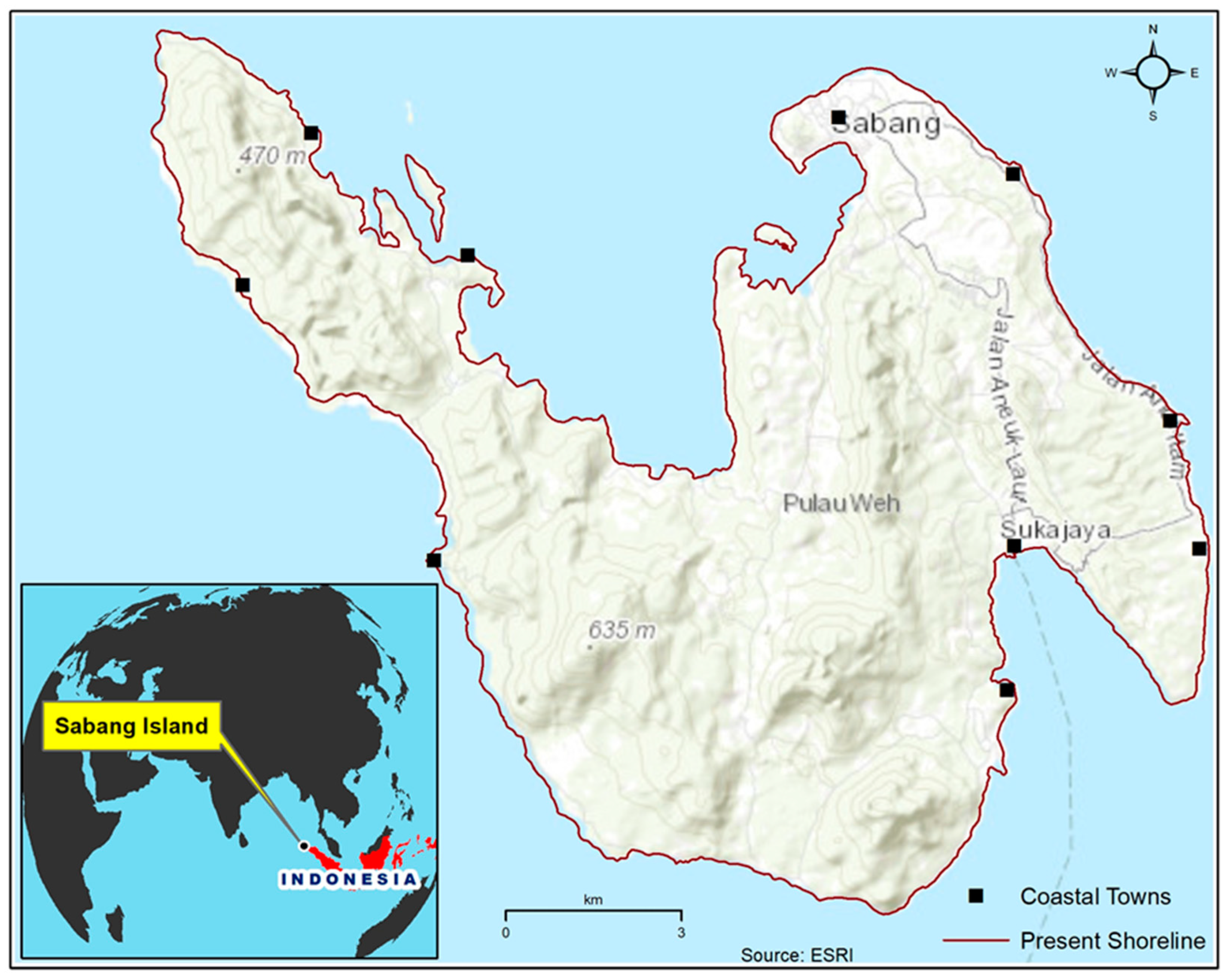
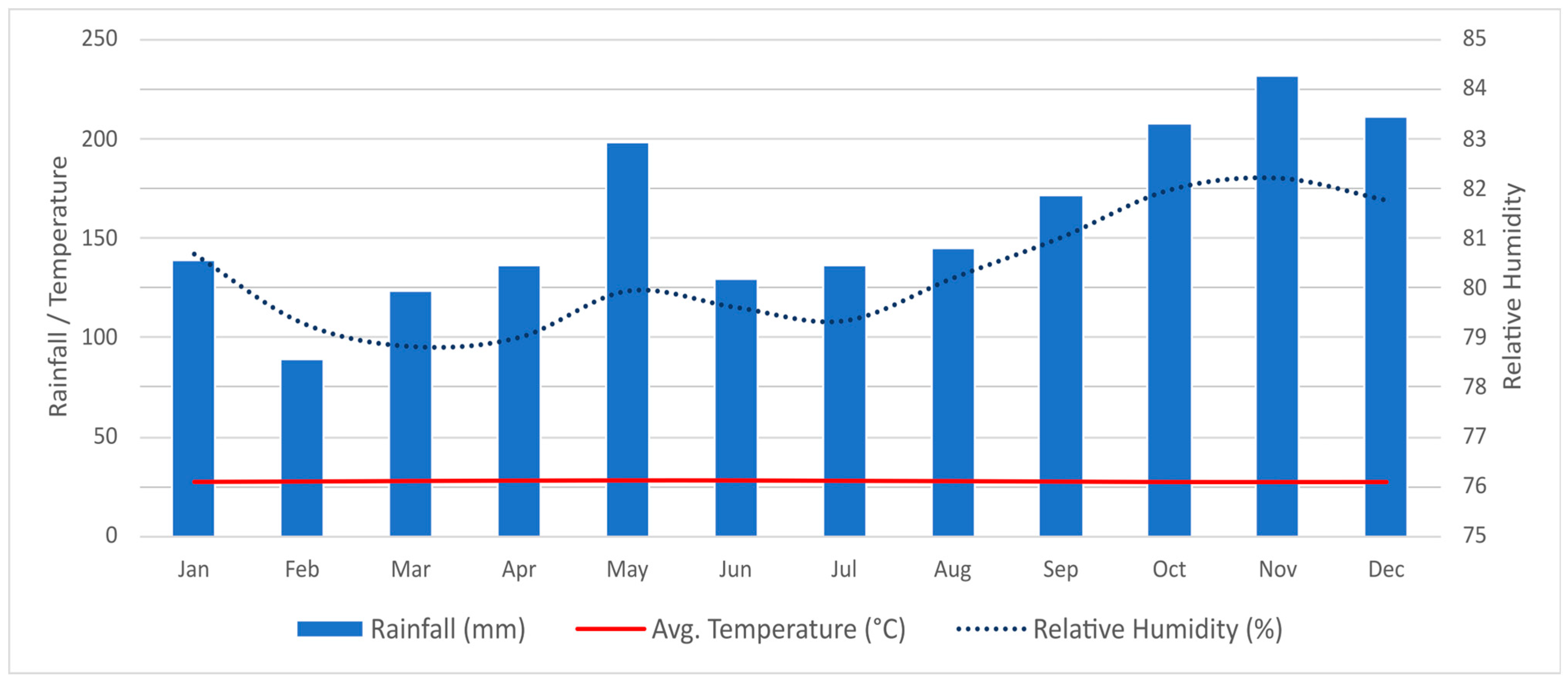
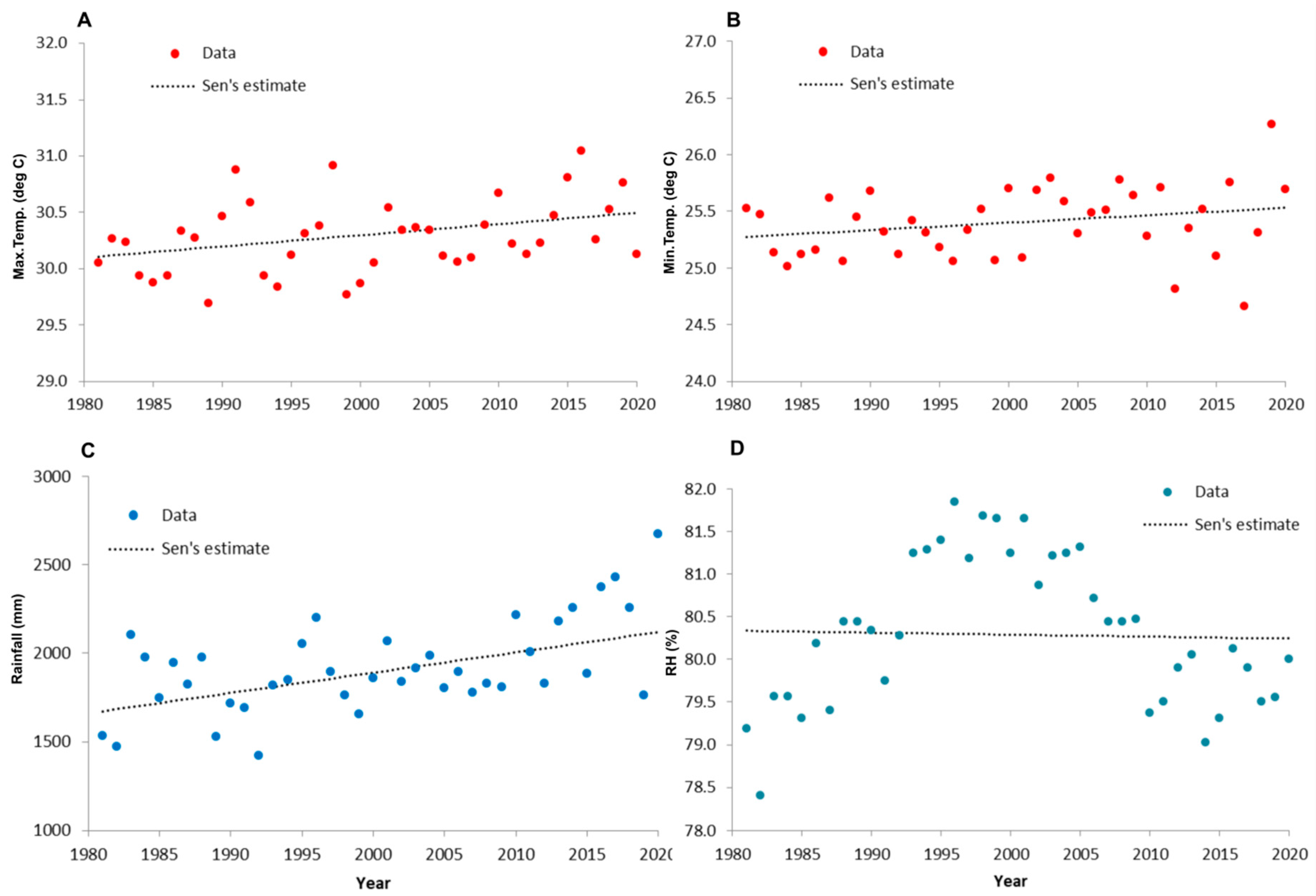
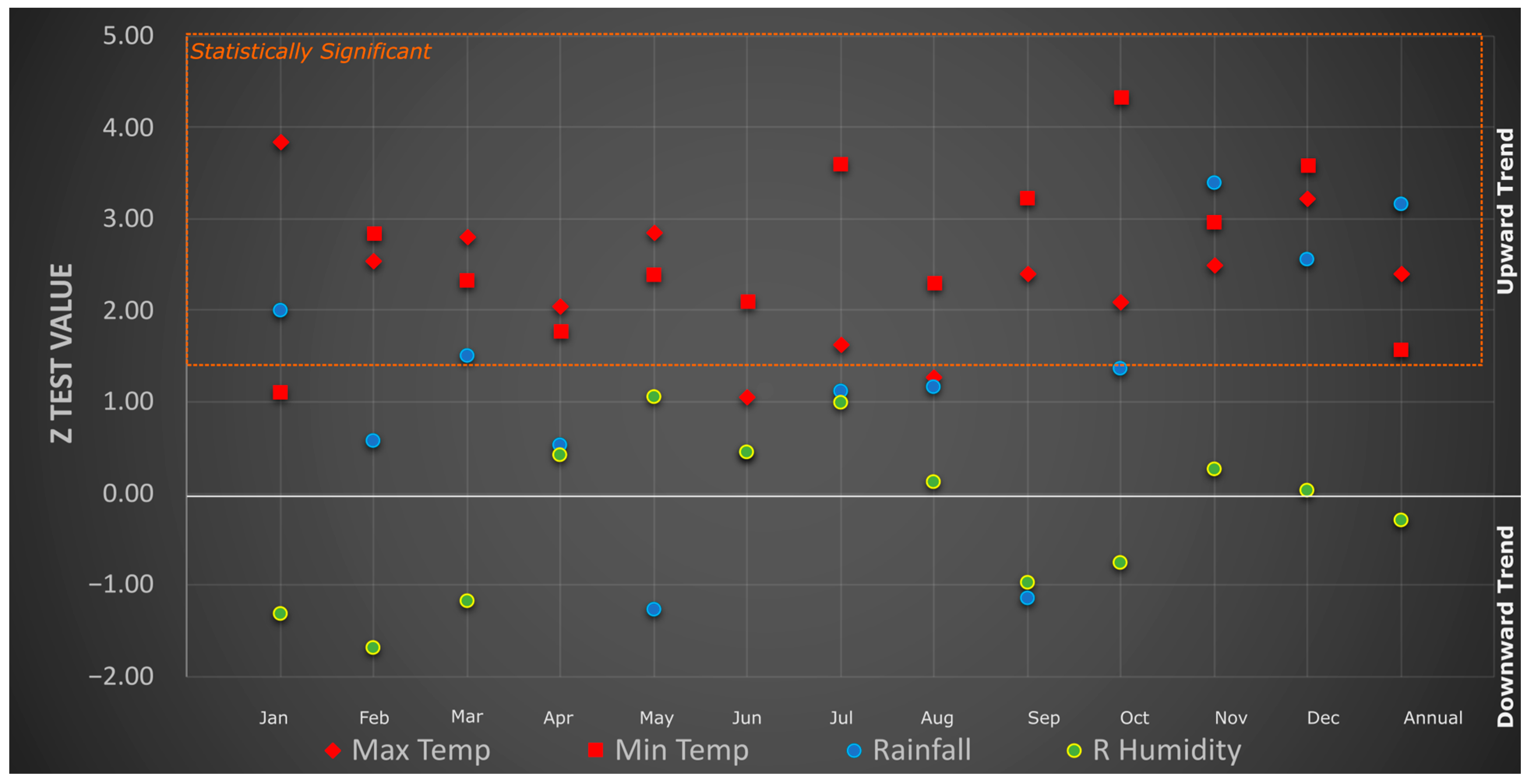
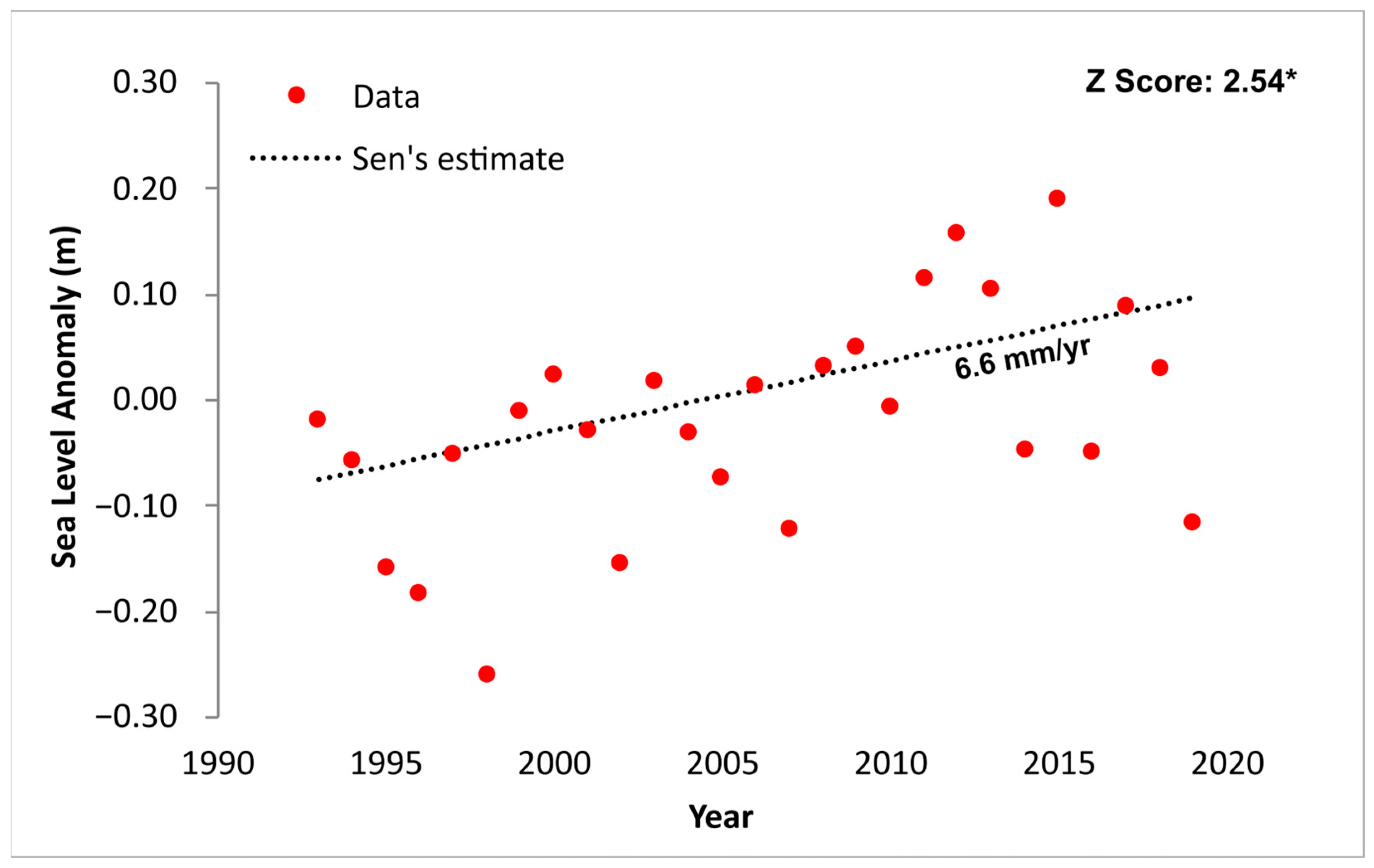
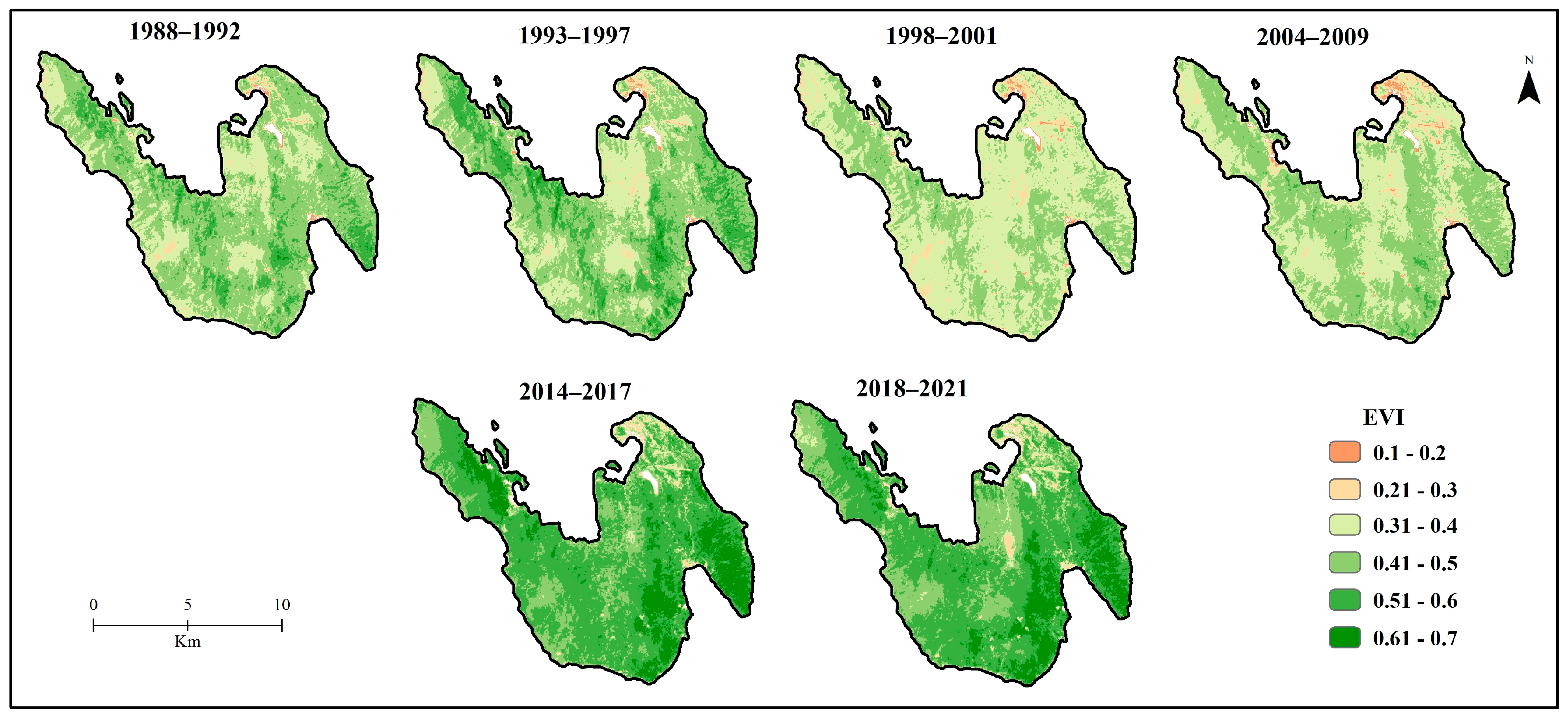
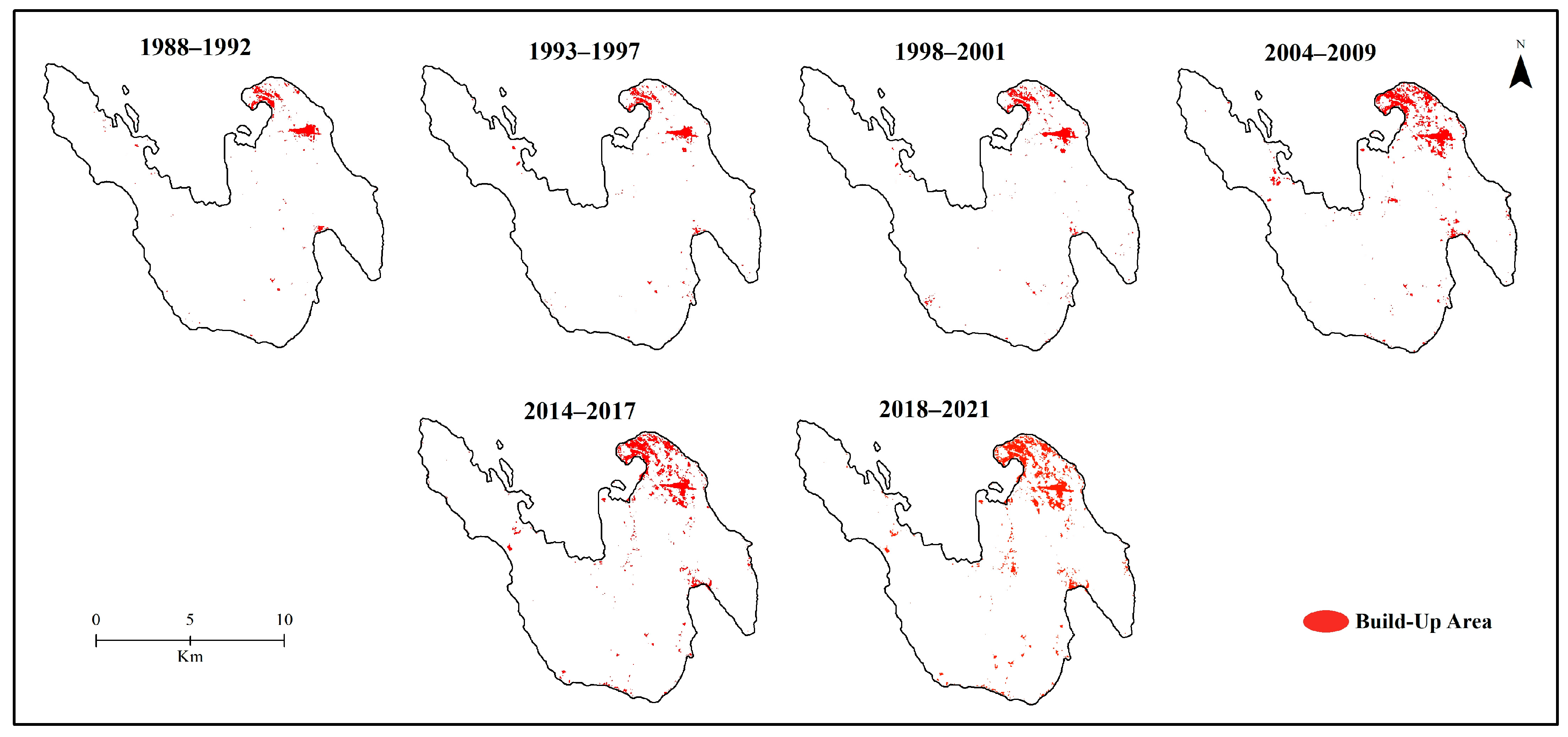
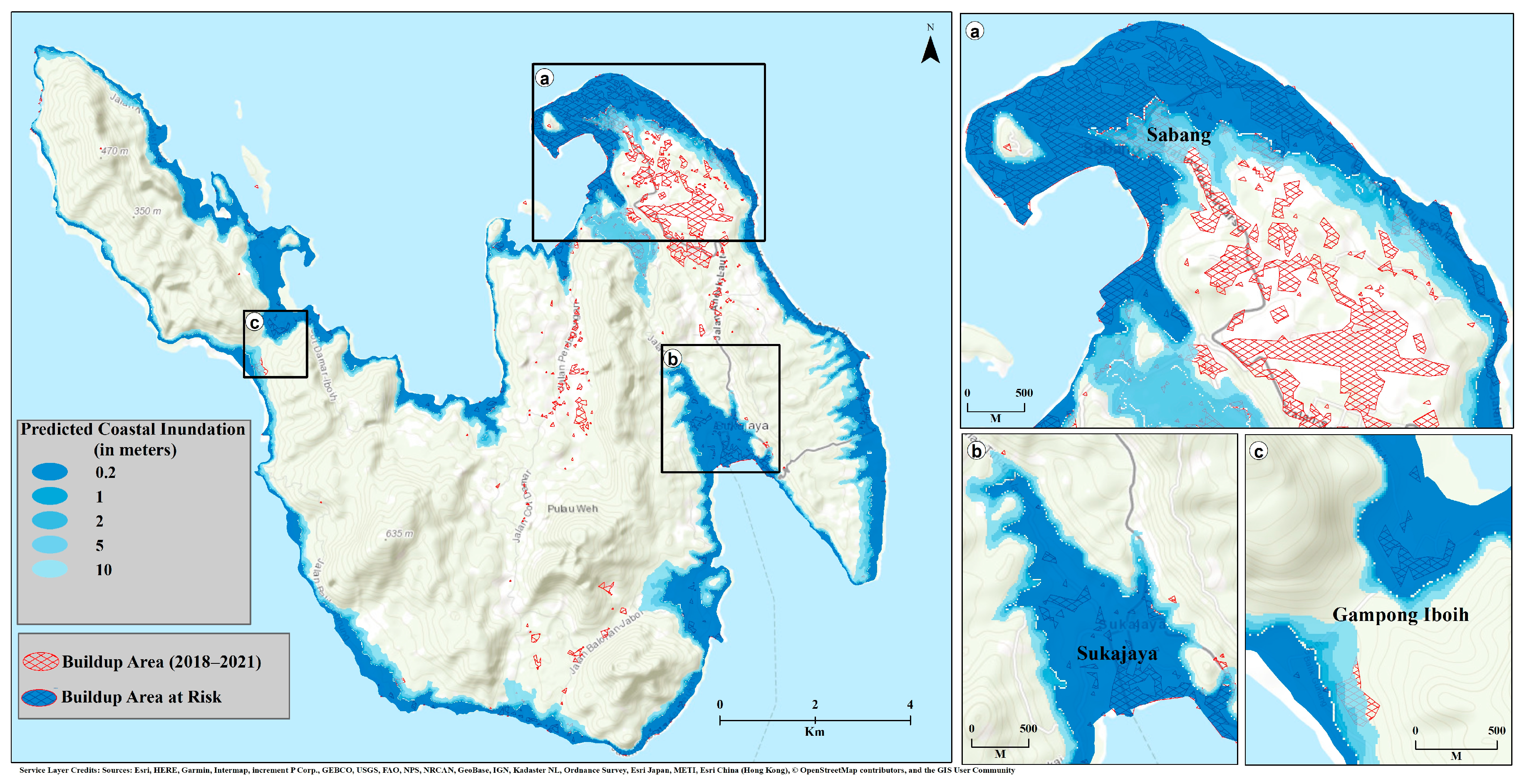
| Sensor/Model | Parameters | Period | Source |
|---|---|---|---|
| MERRA-2 and GEOS 5.12.4 | Minimum Temperature, Maximum Temperature, Rainfall, Relative Humidity | 1981–2020 | [37] |
| LANDSAT 5 and 8, MODIS | Enhanced Vegetation Index | 1988–2021 | [38] |
| LANDSAT 5 and 8 | Normalised Difference Built-Up Index | 1988–2021 | [38] |
| TOPEX/Poseidon, Jason-1, -2, and -3 | Sea Level Anomaly | 1993–2019 | [39] |
| ALOS PALSAR | Digital Elevation Model | 2015 | [40] |
| Year | Built-Up Area (sq km) | Dense Forest Area (sq km) |
|---|---|---|
| 1988–1992 | 1.62 | 91.9 |
| 1993–1997 | 1.69 | 92.5 |
| 1998–2001 | 2.18 | 49.5 |
| 2004–2009 | 4.32 | 70.5 |
| 2014–2017 | 4.67 | 116.5 |
| 2018–2021 | 5.41 | 115.1 |
| Predicted Coastal Inundation (meters) | Built-Up Are (sq km) |
|---|---|
| 0.2 | 2.49 |
| 1 | 2.51 |
| 2 | 2.59 |
| 5 | 2.89 |
| 10 | 3.04 |
Publisher’s Note: MDPI stays neutral with regard to jurisdictional claims in published maps and institutional affiliations. |
© 2022 by the authors. Licensee MDPI, Basel, Switzerland. This article is an open access article distributed under the terms and conditions of the Creative Commons Attribution (CC BY) license (https://creativecommons.org/licenses/by/4.0/).
Share and Cite
Kantamaneni, K.; Christie, D.; Lyddon, C.E.; Huang, P.; Nizar, M.; Balasubramani, K.; Ravichandran, V.; Prasad, K.A.; Pushparaj, R.R.B.; Robins, P.; et al. A Comprehensive Assessment of Climate Change and Coastal Inundation through Satellite-Derived Datasets: A Case Study of Sabang Island, Indonesia. Remote Sens. 2022, 14, 2857. https://doi.org/10.3390/rs14122857
Kantamaneni K, Christie D, Lyddon CE, Huang P, Nizar M, Balasubramani K, Ravichandran V, Prasad KA, Pushparaj RRB, Robins P, et al. A Comprehensive Assessment of Climate Change and Coastal Inundation through Satellite-Derived Datasets: A Case Study of Sabang Island, Indonesia. Remote Sensing. 2022; 14(12):2857. https://doi.org/10.3390/rs14122857
Chicago/Turabian StyleKantamaneni, Komali, David Christie, Charlotte E. Lyddon, Peng Huang, Muhammad Nizar, Karuppusamy Balasubramani, Venkatesh Ravichandran, Kumar Arun Prasad, Robert Ramesh Babu Pushparaj, Peter Robins, and et al. 2022. "A Comprehensive Assessment of Climate Change and Coastal Inundation through Satellite-Derived Datasets: A Case Study of Sabang Island, Indonesia" Remote Sensing 14, no. 12: 2857. https://doi.org/10.3390/rs14122857
APA StyleKantamaneni, K., Christie, D., Lyddon, C. E., Huang, P., Nizar, M., Balasubramani, K., Ravichandran, V., Prasad, K. A., Pushparaj, R. R. B., Robins, P., & Panneer, S. (2022). A Comprehensive Assessment of Climate Change and Coastal Inundation through Satellite-Derived Datasets: A Case Study of Sabang Island, Indonesia. Remote Sensing, 14(12), 2857. https://doi.org/10.3390/rs14122857














